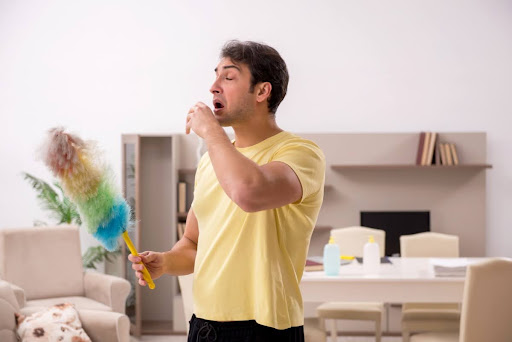We spend so much time inside — whether it’s working, relaxing, or sleeping — that the quality of the air we breathe indoors can have a big impact on our well-being. You might think of air quality as something that only matters outdoors, but the truth is that the air inside your home can be just as polluted, if not more so, than the air beyond your doorstep. Poor air quality can sneak up on you, often going unnoticed until it starts causing noticeable health problems.
In this blog, we’ll walk you through some of the warning signs that your home has poor air quality and what you can do about it. Being able to spot these signs can help you take steps to keep your family healthy.
Why Good Indoor Air Quality Is Important
You may not realize it, but the air inside your home can harbor a variety of pollutants — including dust, pet dander, chemicals, and even mold. Over time, breathing in these indoor air pollutants can lead to health issues like allergies, asthma, and even more serious conditions. That’s why it’s so important to be aware of the quality of the air in your home and to take steps to keep it as clean and fresh as possible.
Don’t Ignore the Red Flags
Your home should be a place where your family can breathe easily. Recognizing the warning signs that your home has poor air quality and taking steps to address them can help protect your health and improve your overall quality of life. If you’re ready to get started, let’s review some of the most common bad indoor air quality symptoms.
1. Frequent Allergy or Asthma Symptoms
One of the first warning signs that your home has poor air quality is an increase in allergy or asthma symptoms. If you or a family member is constantly sneezing, coughing, or dealing with itchy eyes, it might not just be seasonal allergies. Bad indoor air quality symptoms often mimic those of allergies, making it hard to pinpoint the exact cause. If these symptoms worsen when you’re at home but improve when you leave, that’s a clear sign that something in your indoor environment might be triggering them.
How Poor Air Quality Affects Respiratory Health
Unhealthy indoor air quality can have a serious impact on your respiratory health. Pollutants like dust mites, pet dander, and mold spores can all trigger allergic reactions. In homes with poor indoor air quality, these allergens are more likely to be present at higher levels, leading to ongoing discomfort. If you’ve noticed that you’re using your inhaler more often or that your allergies are worse inside than outside, it’s time to consider the air quality in your home.
2. Unpleasant Odors That Linger
Another telltale sign of poor indoor air quality is lingering odors. If you find that certain smells — like cooking odors, smoke, or pet smells — seem to stick around long after they should have dissipated, it might be due to inadequate ventilation or poor air quality. Homes with poor ventilation tend to trap these odors, which can be a sign that pollutants are also being trapped inside.
Why Ventilation Matters
Good ventilation is key to maintaining good indoor air quality. Without adequate ventilation, fresh outdoor air doesn’t get the chance to circulate through your home, meaning that pollutants and odors can build up over time. This can create an unhealthy indoor environment where air pollutants are concentrated, leading to a variety of health problems. If your home always seems stuffy or if you notice unpleasant smells that won’t go away, it might be time to check your ventilation system.
3. Visible Mold Growth
Mold is one of the most obvious warning signs that your home has poor air quality. Mold thrives in damp, poorly ventilated areas, and once it starts growing, it can quickly spread. You might notice mold in areas like the bathroom, basement, or around windows — anywhere that moisture tends to accumulate.
The Health Risks of Mold
Mold isn’t just unsightly; it has the potential to also be dangerous. Exposure to mold spores can cause a range of health problems, from mild allergic reactions to more severe respiratory issues. In some cases, mold exposure can even lead to chronic health conditions. If you spot mold in your home, it’s vital to address it right away, not only by cleaning it up but also by addressing the underlying indoor air problems that allowed it to grow in the first place.
4. Excessive Dust Buildup
Dust is a common part of any home. However, if you find that your home is getting dustier than usual, or if dust seems to settle quickly after you’ve cleaned, it could be a sign of unhealthy indoor air quality. Dust is made up of tiny particles, including dead skin cells, pet dander, and even bits of clothing fibers. When your home has poor indoor air quality, these particles can circulate through the air and settle on surfaces more frequently.
The Role of Air Filters
One way to combat dust buildup and improve indoor air quality is by using high-quality air filters in your heating and cooling systems. These filters are designed to capture dust and other airborne particles before they can circulate through your home. If you’re noticing a lot of dust, it might be worth checking your air filters to see if they’re possibly carrying indoor air pollutants into your home and need to be replaced. Dirty or clogged filters can reduce the efficiency of your heating systems and air conditioners.
5. Unexplained Health Issues
Finally, if you or your family members are experiencing unexplained health issues — like frequent headaches, fatigue, or respiratory problems — it could be due to unhealthy indoor air quality. These symptoms can be caused by a variety of factors, including exposure to indoor air pollutants like volatile organic compounds (VOCs) or carbon monoxide.
Identifying Indoor Air Sources
To identify potential sources of indoor air pollution, take a close look at your home’s environment. Are you using products that contain VOCs, like paints, cleaners, or air fresheners? Is there a gas stove or fireplace that might be releasing carbon monoxide? Even everyday items like furniture and carpets can emit pollutants over time. If you’re noticing health problems that don’t seem to have an obvious cause, it might be time to consider the quality of the air you’re breathing.
Improve Your Indoor Air Quality With Busy Bee
If you’re concerned about the air quality in your home or are experiencing any of the bad indoor air quality symptoms mentioned above, don’t wait to take action. Busy Bee Plumbing, Heating & Air Conditioning offers a range of services, including air purification and air duct cleaning in Nashville, TN, to help you create a healthier home environment. We also serve the residents of:
- Lebanon, TN
- Mt. Juliet, TN
- Hermitage, TN
- Franklin, TN
- Brentwood, TN
- Cookeville, TN
- Murfreesboro, TN
- Clarkesville, TN
- Hendersonville, TN
- Smyrna, TN
- Thompson Station, TN
- Spring Hill, TN
- La Vergne, TN
- Columbia, TN
Take Action Today for Healthier Air Tomorrow!
Indoor air quality problems can affect your family’s health, so if you’ve noticed any of these bad indoor air quality symptoms, now is the time to take action. Whether you’re ready to invest in an air purifier or want to schedule a professional air duct cleaning, there are plenty of ways to improve indoor air quality and create a healthier living space.
At Busy Bee Plumbing, Heating & Air Conditioning, our team of professionals is ready to assist with all your indoor air quality needs. Contact us at 615.991.2145 to schedule your air purification services in Nashville, TN, or one of the surrounding communities!





